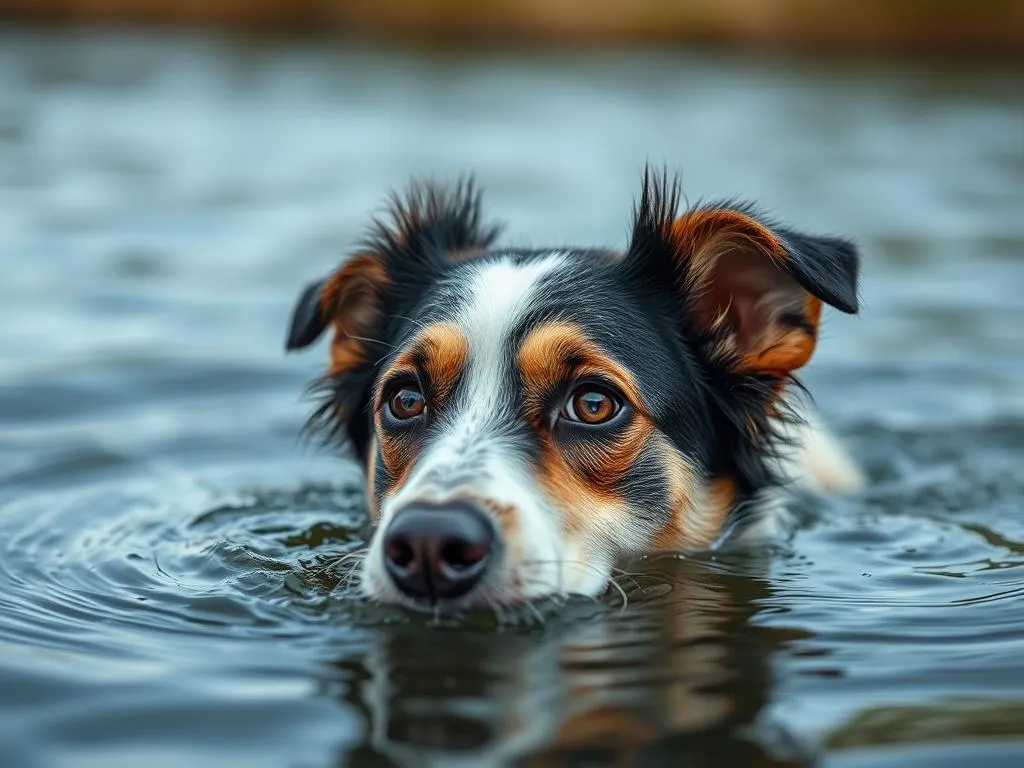
Understanding why your dog may be frightened of water can be key to addressing this common behavioral issue. Why is my dog scared of water? This question can often lead to a deeper understanding of your dog’s fears and how to effectively train them. Recognizing the underlying reasons for this fear is essential to developing a training strategy that works.
Understanding Canine Fear
Definition of Fear in Dogs
Fear in dogs is a natural response to perceived threats or stressful situations. It’s important to differentiate fear from anxiety; while fear is a reaction to a specific stimulus (like water), anxiety tends to be more generalized and can occur without a clear trigger. A fearful dog may react with avoidance, while an anxious dog may exhibit a range of behaviors due to uncertainty.
Common Signs of Fear in Dogs
Signs of fear can manifest both physically and behaviorally. Common indicators include:
- Trembling or Shaking: Dogs may shake when scared, which can sometimes be confused with excitement.
- Hiding or Cowering: A fearful dog may seek refuge in a corner or under furniture.
- Barking or Whining: Vocalizations can signal distress.
- Tail Position: A lowered or tucked tail often indicates fear.
- Avoidance Behaviors: This can include turning away or trying to escape the situation.
These signs can vary significantly between breeds and individual dogs. Understanding your dog’s unique personality is crucial in identifying their specific fear responses.
Reasons Why Dogs Are Scared of Water
Lack of Exposure
One of the most significant reasons why dogs may fear water is a lack of early exposure. Puppies go through a critical socialization period, typically between 3 and 14 weeks of age, where they learn to interact with their environment. If a dog has not been exposed to water during this formative time, they may develop a fear of it later in life.
Traumatic Experiences
Negative experiences can have a profound impact on a dog’s relationship with water. For instance, if a dog accidentally falls into a pool or gets swept away by a wave at the beach, these traumatic events can lead to a lasting fear of water. Even minor incidents, like being splashed unexpectedly, can instill fear.
Genetic Predisposition
Certain breeds may be genetically predisposed to fearfulness, including an aversion to water. For example, breeds that were not originally bred for water-related tasks, such as some terriers, may not instinctively enjoy being in or around water. Understanding breed tendencies can help owners manage expectations regarding their dog’s comfort with water.
Sensory Sensitivity
Dogs have heightened senses, and some may be particularly sensitive to the sounds and sensations associated with water. The splashing of water or the sound of waves can be overwhelming for some dogs, leading to fear. Past experiences that were negative can exacerbate this sensitivity, making the dog associate water with unpleasant feelings.
Assessing Your Dog’s Fear of Water
Observational Techniques
To better understand your dog’s fear of water, careful observation is essential. Pay attention to your dog’s body language when they are near water. Indicators like stiff body posture, a lowered head, or rapid panting can signal fear. Additionally, vocalizations such as whining or barking should be noted.
Professional Assessment
If your dog’s fear seems severe or persistent, seeking a professional assessment may be beneficial. A veterinarian or a certified dog trainer can provide insights into your dog’s behavior. They may conduct a behavioral assessment, which might include observing the dog in various water-related situations to determine the extent of the fear.
Training Techniques to Help Overcome Fear
Desensitization
Desensitization involves gradually exposing your dog to water in a controlled and non-threatening manner. Start with small, manageable steps:
- Introduce the Sound: Play recordings of water sounds at a low volume.
- Visual Exposure: Allow your dog to observe water from a distance without any pressure to engage.
- Gradual Immersion: Once your dog is comfortable with the sounds and sights, slowly introduce them to shallow water, encouraging them to explore at their own pace.
Positive Reinforcement
Positive reinforcement is a powerful training tool. Encourage your dog to approach water by offering treats, praise, or their favorite toy when they exhibit calm behavior around water. This helps create positive associations that can diminish fear over time.
Controlled Exposure
Controlled exposure to water can significantly help in alleviating fears. Choose calm, shallow environments such as kiddie pools or quiet streams where your dog feels safe. Always supervise your dog during these sessions, allowing them to explore at their own pace without forcing them into the water.
Using Toys and Games
Incorporating toys can transform the water experience into a fun activity. Use floating toys to entice your dog to play in shallow areas. Games like fetch can create excitement about water and help shift the focus away from fear.
Professional Training Programs
If your dog’s fear persists despite your efforts, consider enrolling them in a professional training program. These programs often focus on behavioral issues and can offer specialized techniques to address your dog’s fear of water. Group classes can provide socialization opportunities, while private sessions may offer tailored strategies to suit your dog’s specific needs.
Maintaining Progress and Monitoring Behavior
Consistency is Key
Consistency in training practices is essential. Regular exposure to water, combined with ongoing positive reinforcement, helps maintain progress. Engage in short, frequent sessions rather than long, overwhelming ones, and gradually increase the level of exposure as your dog becomes more comfortable.
Recognizing Setbacks
Be aware that setbacks can occur during training, especially if your dog has a particularly fearful or traumatic experience. Signs of regression might include increased avoidance or backtracking in training progress. If this happens, revisit earlier steps of the training process and allow your dog to regain confidence before moving forward.
Celebrating Small Wins
Celebrate every small victory along the way. Whether it’s your dog approaching water without hesitation or simply sitting calmly near it, these milestones are important. Acknowledging these achievements reinforces positive behavior and encourages further progress.
Conclusion
Understanding why is my dog scared of water is crucial for developing effective training strategies. By recognizing the underlying causes of this fear, such as lack of exposure, traumatic experiences, genetic predisposition, and sensory sensitivity, owners can approach training with empathy and patience.
Consistent training practices, coupled with positive reinforcement and gradual exposure, can help dogs overcome their fear of water. Always remember to celebrate small victories and remain attuned to your dog’s emotional needs throughout the process. The journey of overcoming fear is not only about training but also about building trust and confidence between you and your dog.









